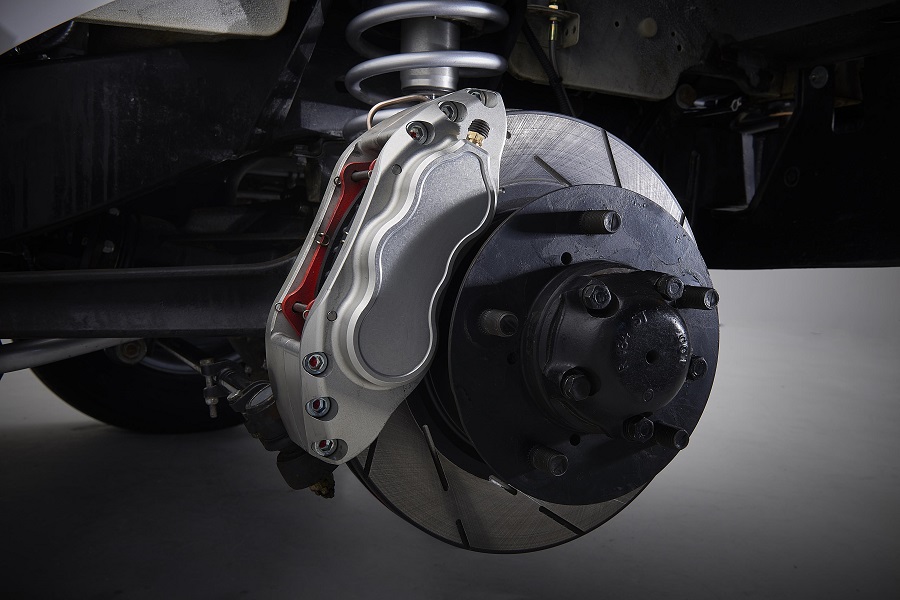Need some serious stopping power for your modified build? Here are some of the best big brake kits that the aftermarket has to offer.
Looking for more than just brake pads and rotors? If you’ve got a big budget and are looking for the biggest braking gains possible, then the answer is simple: get a big brake kit! However, that term is wonderfully vague, so you might be wondering what these kits actually contain…
What is a big brake kit?
Essentially, a big brake kit is a comprehensive package, usually comprised of every part that a car’s braking system needs. Let’s start with the rotors, or discs. Compared to regular ones, the rotors found in a big brake kit are – yep, you guessed it – larger, with a wider surface area. These bigger rotors provide a greater surface area for friction, and are much better at heat dissipation too if they’re drilled or grooved, meaning they’ll be able to cope with much more extreme braking scenarios.
Then, there’s the pads and calipers. The pads in a big brake kit will likely feature more compound material, a more aggressive compound material, or both in order to increase potential friction. If you’ve got bigger pads, you’ll need bigger calipers to put them in. Often, the calipers will be a monobloc design for better structural rigidity, therefore providing a more reliable contact patch between the pad and rotor. You’ll also notice that the amount of pistons a caliper has typically correlates with how big your rotors are. If you’ve got average-sized rotors you might have 4-piston calipers, ranging up to around 10 if you’re dealing with real heavy-duty stuff. Most companies will throw in the accompanying brake lines and fluid too.
Having spent years immersed in the modified car scene, I’m well placed to advise you on which brands are worthy of consideration. Here are some of the best big brake kits that money can buy.
Best Big Brake Kits
How we chose the products
While we haven’t been able to test every single brand mentioned here first-hand, these recommendations are based on Fast Car‘s experience and expertise. Every member of the Fast Car staff, myself included, is very familiar with automotive performance aftermarket. It’s what our brand is all about, after all! As a result, we understand which brands you should consider dealing with… and which you shouldn’t. Each of the brands and products mentioned in this article have earned their place on our shortlist through positive word of mouth amongst like-minded driving enthusiasts.
At a glance:
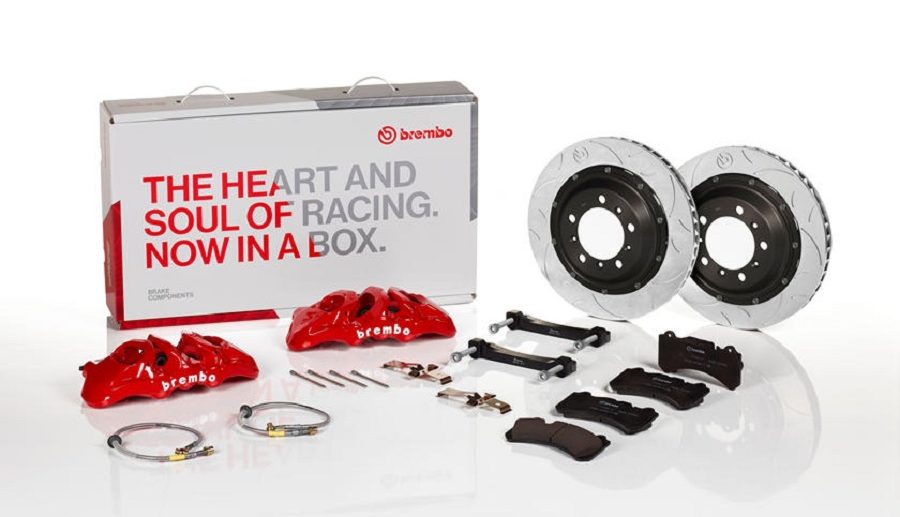
Brembo
Brembo is probably the most well-known braking system manufacturer on the planet, and for good reason. There isn’t a single competitor that can claim the sort of technical innovation and motorsport prestige that Brembo has achieved over the years.
To give you an idea, Brembo brakes have played a part in 26 Formula One driver’s championship titles. They’ve also had 30 constructor’s championship wins. And on top of that, numerous performance marques across the globe trust Brembo to provide the braking systems for their OEM models. So, if you’re after a quality performance upgrade, you’ll be in safe hands.
There’s a handful of big brake kits to choose from amongst the Brembo product range, but we’ve picked out two to mention here. The Gran Turismo BM package is the next step up from a simple pad and rotor upgrade. This adds the choice of either drilled or slotted rotors (that are higher quality than Brembo’s entry-level TY3s), 4, 6, or 8-piston calipers, high-performance pads, and metal-braided hoses. You’ll mostly feel the benefits of these on the track, but even at lower street speeds, braking performance will be more decisive.
Hardcore lap-time chasers might prefer the Gran Turismo R kit though. In Brembo’s words, this is “the most sophisticated high performance braking system ever manufactured for a car”. The highly-developed calipers are arguably the GT R kit’s highlight, though you also get two-piece rotors, accompanying pads, and stainless-steel Goodridge hoses.
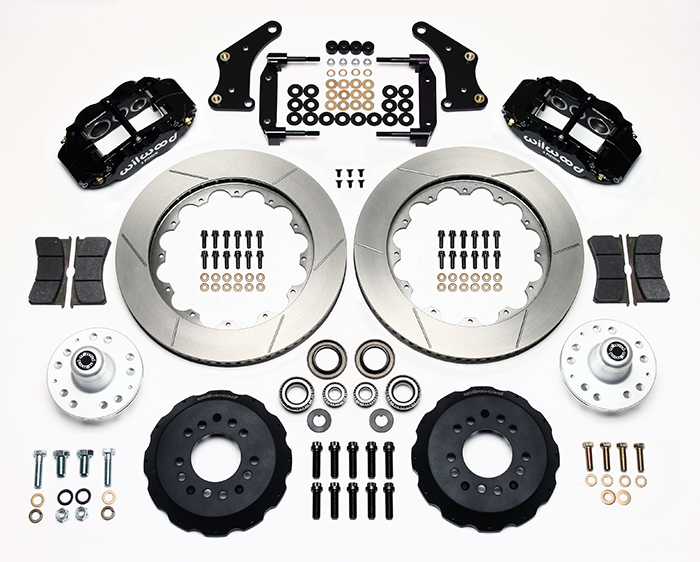
Wilwood
Based in California, Wilwood is an American braking system manufacturer that’s been around since 1977. During that time, the company has amassed quite the reputation, not just in the US, but globally too. From competitive motorsport, to the world of industry and agriculture, Wilwood has developed high performance brakes for everything from go-karts to military Humvees.
In fact, their current product range is absolutely titanic. Right now, they offer more than 300 different brake calipers, 200 rotor designs and a whole host of upgraded supporting parts. Naturally, we can’t go through all of them here, but in general, here’s what you can expect from Wilwood upgrade kits:
The first thing to mention is that there tends to be two core branches of design when it comes to Wilwood big brakes kits. The first is the two-piece traditional ‘hat’ style upgrade which is designed to fit on top of the stock wheel hub. However, there is also the option to go for a design where the hub is further integrated into the upgrade. These are primarily designed for use in older vehicles like some classic American muscle cars which don’t feature ABS.
As far as calipers go, there’s a number of different options based on size and how much stopping strength you need. Entry-level options or options for more compact cars tend to come with four pistons, whereas the more high-end Wilwood kits have six. Speaking of high-end kits, you can even source carbon-ceramic rotors from Wilwood, but unless you’re running an extreme heavyweight or a serious track/race/time attack car, then those are likely to be a bit overkill.
Click here to discover the Wilwood big brake kit range in full.

AP Racing
AP Racing has become one of the best braking system companies in the world, thanks to its ‘Race to Road’ approach to development. In short, all of AP’s core technology has been engineered to succeed on the race circuit, before trickling down into OEMs and the street performance aftermarket.
If you’re interested in a full big brake kit, AP supply upgrade packages for models from: Audi, BMW, Ford, Honda, Jaguar, Mazda, Mitsubishi, Nissan, Peugeot, Subaru, Toyota, and Volkswagen.
These packages will include a set of slotted rotors, high performance pads and calipers, brake lines, and all the hardware you need to fit the parts to your car. Occasional track day use is well within these braking systems’ capabilities, though they’ve been geared towards improving less demanding street performance instead. So, if you want something that blends braking ability with everyday refinement, these AP kits would be a good shout.
To browse the range of AP Racing big brake kits, click here.
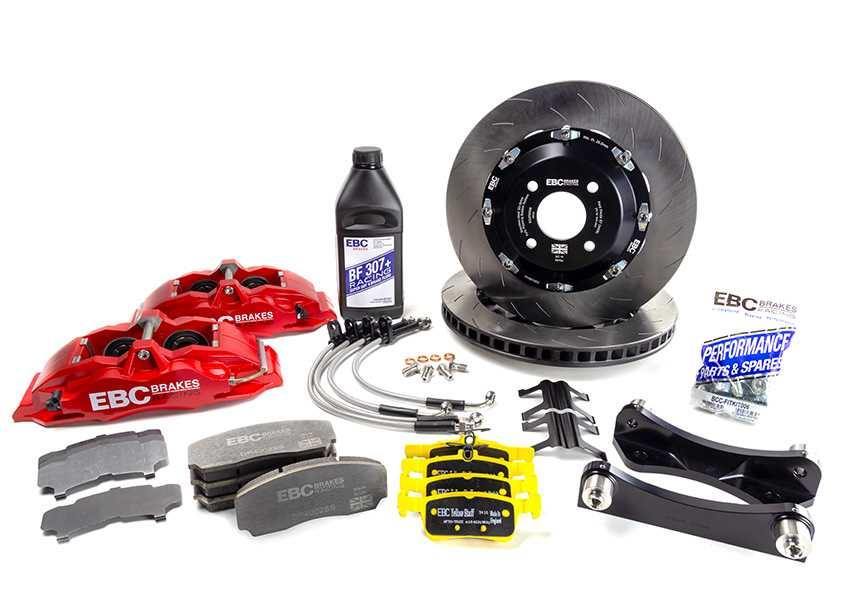
EBC Brakes
Despite the Brits’ recent self-inflicted trade difficulties, EBC Brakes are still a major supplier to the European aftermarket, and wouldn’t be considered out of place further abroad either. EBC’s most well-known products are its color-coordinated range of brake pads, however they do supply full big brake kits as well.
These are made from stainless steel (to ensure parts are long lasting and do not corrode), and aerospace-grade aluminum (for great strength and durability). One big difference that sets EBC’s Balanced Big Brake Kit range apart from others is that fact that it takes into consideration both axles. Whereas many brands simply focus on the front axle, EBC kits also feature rear brake pads and hoses for a more unified braking response at either end of the car.
Those pads are EBC’s famous YellowStuff variant which is considered one of the best brake pad compounds around for street builds that also want to feel capable on a track. On the (minor) downside, the kits come with two-piece calipers rather than monoblocs, and only four pistons (though six-piston variants are promised soon). That said, EBC claims that the bolting structure they use to connect the two pieces is actually *more* sturdy than a monobloc. The calipers rub the pads against a set of grooved two-piece floating rotors, which should be ample strong enough for 99% of braking scenarios.
Check out the EBC big brake kit range here.
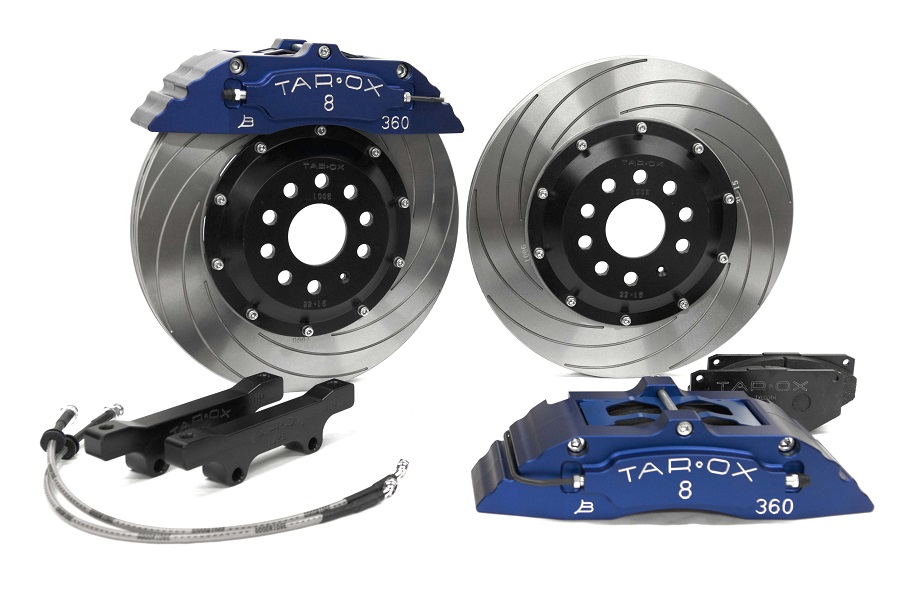
Tarox
The lightweight big brake kits from Tarox are designed and created via the use of high-tech ECU plug-ins and pedal pressure sensors. The data gathered from a car’s stock capabilities is then used to formulate the perfect brake upgrade for it, designed not only to maximize performance, but also strike a balance with pedal feel and durability, too. The size of a caliper, for instance, and the number of pistons it contains is tailored to each individual car that Tarox caters for.
Like the EBC offerings, Tarox big brake kits come with bolted two-piece calipers rather than monoblocs, but unlike EBC kits you get a lot more choice when it comes to rotor design. The F2000 features long curved grooves, whereas the Sport Japan is drilled and grooved. The C83 has short straight grooves, while the D95 is drilled only. Finally, the ZERO has a plain surface, like you see on most OEM set-ups.
In fact, to prove to you how much we rate Tarox, we used one of their BBK kits on our very own FN2 Civic project car. Watch the video above to see Midge install it. Or, if you want to check out the Tarox range in greater depth, click here.
How to buy the best big brake kit
A lot of this decision comes down to the rotors and pads. When it comes to choosing the best brake rotors for your car, there are two main factors to look out for; maximum stopping force, and ability to dissipate heat.
Rotors
A larger rotor diameter means two things – more surface area for the pad compound to bite (thus causing more stopping friction), and more surface area for heat to dissipate. So, put simply, bigger rotors perform better than smaller ones. Holes and slots, meanwhile, are a valuable upgrade if you’re keen on spirited driving as they allow room for gas and dust to pass along. As such, it keeps your brakes cool, and tidies up the rotor surface of debris to ensure that the pads always have the desired level of bite. We’d suggest learning more about the nuances of slotted rotors vs. drilled rotors before deciding on a set for your car.
Oh, and if you’ve got money burning a hole in your pocket, ceramic brake rotors are well worth the investment. This high-end compound is significantly lighter than the regular iron designs that many brands use, and they tend to last longer too.
Pads, Calipers & Lines
As for pads, again it depends on what your intentions are. If you want an upgrade for your daily driver, you should aim for a pad which gives you a nice balance; improved friction, but without causing too much noise or brake dust. On the other hand, if you’re buying pads for a car which you’re only going to use on track, then you only need to worry about friction performance and resistance to fade. Good pads need good calipers too. Larger calipers with a greater number of pistons are able to deploy a greater amount of force onto the pad, which in turn aids pad performance against the rotor.
Fluid and brake lines shouldn’t make or break a purchase decision as they’re simple enough to replace or upgrade, but in an ideal world you want steel-braided lines and DOT 4 (or DOT 5+ in extreme track applications) brake fluid.

